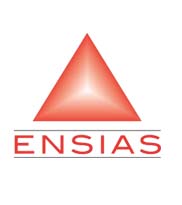- Accueil
-
L'Ecole
-
FORMATIONS
-
FORMATION INGENIEUR
-
Nouvelles filières offertes 2021
- Ingénierie Intélligence Artificielle (2IA)
- Smart Supply Chain & Logistics (2SCL)
- Business Intelligence & Analytics (BI&A)
- Génie de la Data (GD)
- Génie Logiciel (GL)
- Ingénierie Digitale pour la Finance (IDF)
- Smart System Engineering (SSE)
- Ingénierie en Data Science and IOT (IDSIT)
- Sécurité des Systèmes d’Information (SSI)
- REGLEMENT DES ETUDES DE L’ENSIAS CYCLE INGENIEUR
-
Nouvelles filières offertes 2021
-
FORMATION MASTER
- Master de recherche Bioinformatique et Modélisation des Systèmes Complexes Appliquée à la Santé.
- Master Internet des Objets : Logiciel et Analytique (MIOLA)
- Master Recherche en Science de Données et Big Data
- Nouveau Master de Recherche en Sécurité Systèmes et Services (M3S)
- NOUVEAU Master de Recherche : Cloud and high Performance Computing (CLOUDHPC)
-
FORMATION INGENIEUR
- FORMATION CONTINUE
-
Recherche
- INTERNATIONAL
- ENTREPRISES
- VIE ESTUDIANTINE
- BIBLIOTHEQUE
LES DERNIÈRES INFORMATIONS
TimeSpec4LULC: a global multispectral time series database for training LULC mapping models with machine learning
| Titre | TimeSpec4LULC: a global multispectral time series database for training LULC mapping models with machine learning |
| Publication Type | Journal Article |
| Year of Publication | 2022 |
| Authors | Khaldi, R, Alcaraz-Segura, D, Guirado, E, Benhammou, Y, A. Afia, E, Herrera, F, Tabik, S |
| Journal | Earth System Science Data |
| Volume | 14 |
| Pagination | 1377-1411 |
| Mots-clés | Land cover, Land use, Machine learning, MODIS, multispectral image, spatiotemporal analysis, Time series analysis |
| Abstract | Land use and land cover (LULC) mapping are of paramount importance to monitor and understand the structure and dynamics of the Earth system. One of the most promising ways to create accurate global LULC maps is by building good quality state-of-the-art machine learning models. Building such models requires large and global datasets of annotated time series of satellite images, which are not available yet. This paper presents TimeSpec4LULC 10.5281/zenodo.5913554;Currency sign, a smart open-source global dataset of multispectral time series for 29 LULC classes ready to train machine learning models. TimeSpec4LULC was built based on the seven spectral bands of the MODIS sensors at 500ĝ€¯m resolution, from 2000 to 2021, and was annotated using spatial-temporal agreement across the 15 global LULC products available in Google Earth Engine (GEE). The 22-year monthly time series of the seven bands were created globally by (1) applying different spatial-temporal quality assessment filters on MODIS Terra and Aqua satellites; (2) aggregating their original 8ĝ€¯d temporal granularity into monthly composites; (3) merging Terraĝ€¯+ĝ€¯Aqua data into a combined time series; and (4) extracting, at the pixel level, 6ĝ€¯076ĝ€¯531 time series of size 262 for the seven bands along with a set of metadata: geographic coordinates, country and departmental divisions, spatial-temporal consistency across LULC products, temporal data availability, and the global human modification index. A balanced subset of the original dataset was also provided by selecting 1000 evenly distributed samples from each class such that they are representative of the entire globe. To assess the annotation quality of the dataset, a sample of pixels, evenly distributed around the world from each LULC class, was selected and validated by experts using very high resolution images from both Google Earth and Bing Maps imagery. This smartly, pre-processed, and annotated dataset is targeted towards scientific users interested in developing various machine learning models, including deep learning networks, to perform global LULC mapping. © 2022 Rohaifa Khaldi et al. |
| URL | https://www.scopus.com/inward/record.uri?eid=2-s2.0-85127624906&doi=10.5194%2fessd-14-1377-2022&partnerID=40&md5=90f9e45c7b39e149ab387a54f4392d6a |
| DOI | 10.5194/essd-14-1377-2022 |
Revues:
LIENS UTILES
Localisation
Contactez-nous
ENSIAS
 Avenue Mohammed Ben Abdallah Regragui, Madinat Al Irfane, BP 713, Agdal Rabat, Maroc
Avenue Mohammed Ben Abdallah Regragui, Madinat Al Irfane, BP 713, Agdal Rabat, Maroc
![]() Télécopie : (+212) 5 37 68 60 78
Télécopie : (+212) 5 37 68 60 78
![]() Secrétariat de direction : 06 61 48 10 97
Secrétariat de direction : 06 61 48 10 97
Secrétariat général : 06 61 34 09 27
Service des affaires financières : 06 61 44 76 79
Service des affaires estudiantines : 06 62 77 10 17 / n.mhirich@um5s.net.ma
Résidences : 06 61 82 89 77
- Compteur de visiteurs:567,063
Education - This is a contributing Drupal Theme
Design by WeebPal.
Design by WeebPal.



































